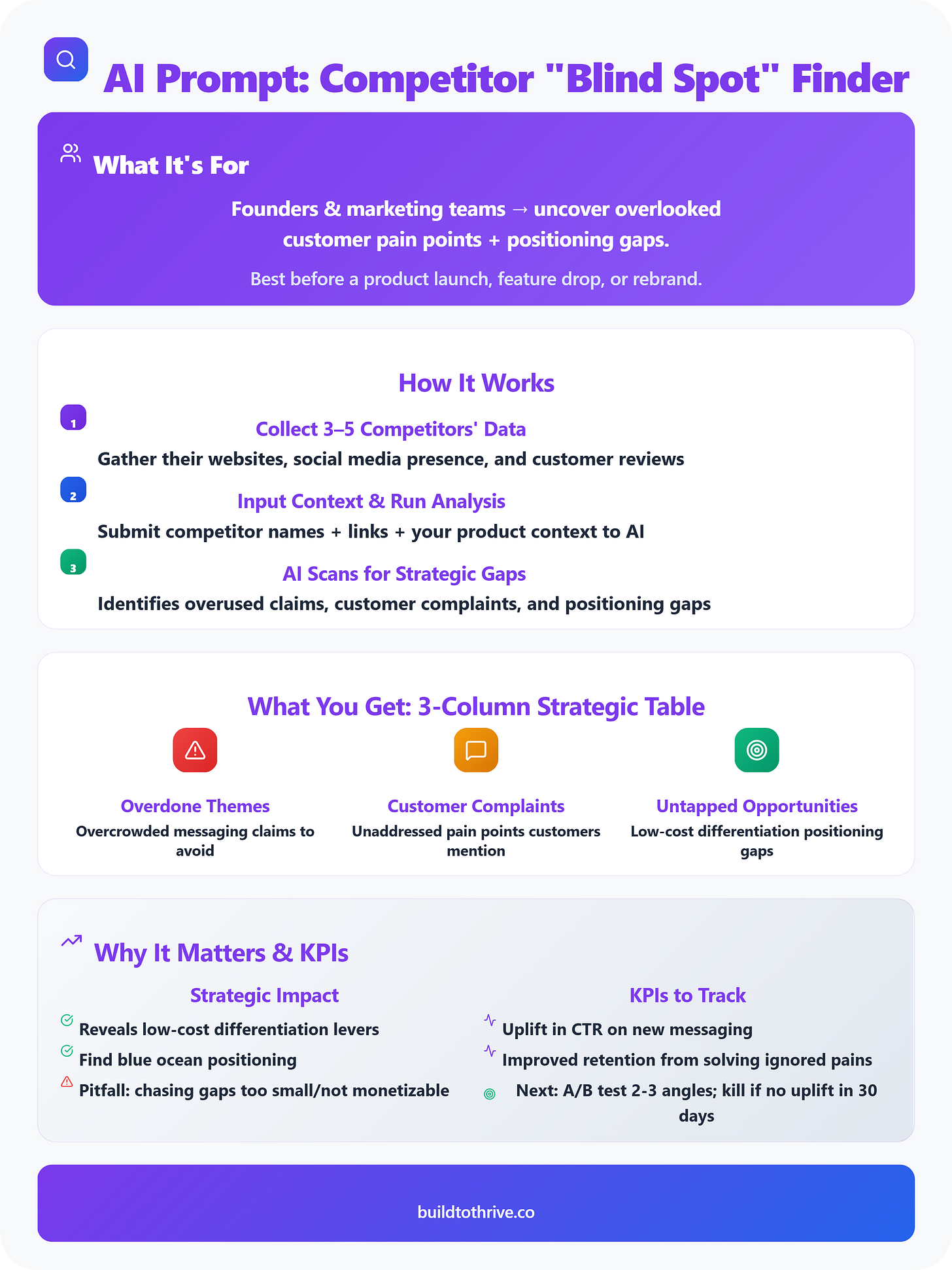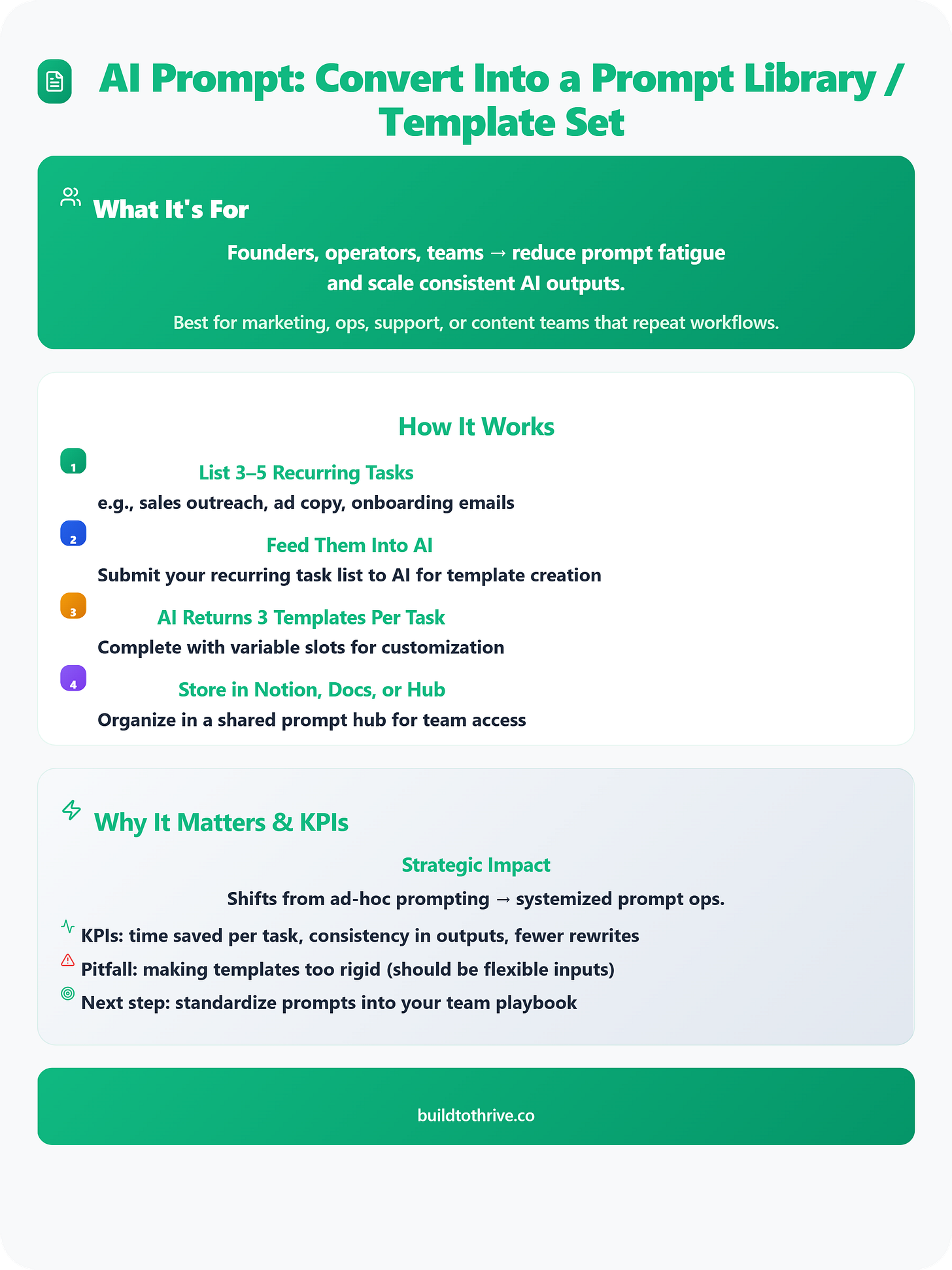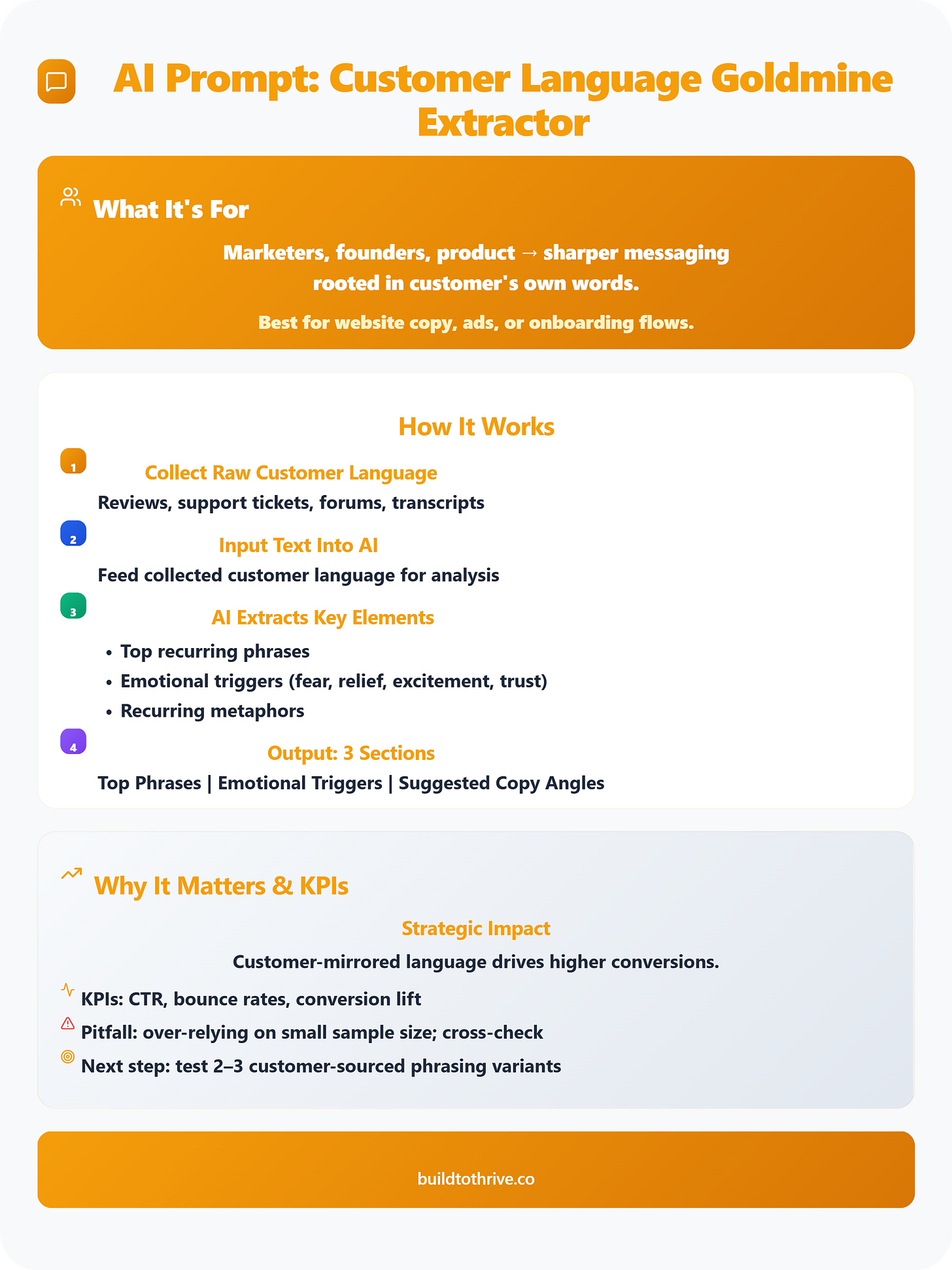Build to Thrive | The Blueprint | Week of September 29th, 2025
Prompts, Tools and Trends to grow smarter, scale efficiently and stay ahead
Build to Thrive delivers strategies, playbooks, trends and tools that help you build smarter, scale your business and stay ahead of the game.
Editorial note: A quick thank-you to the subscribers who’ve shared feedback on making The Blueprint more engaging and relevant. Your thoughts directly shape where we go next. If there’s something you’d like to see more of, just hit reply or comment — I’d love to hear it.
Table of Contents
PROMPTS
Competitor Blindspot Finder
Prompt Library Template Set
Customer Language Goldmine Extractor
FEATURED ARTICLE: The Science of Execution: Why Most Founders Stay Stuck (and How to Break Through in 90 Days)
AI TRENDS: Top 5 Curated Stories of the Week
BIG IDEA: Trust, Oversight & Human-in-the-Loop — Your Next Competitive Edge
SPRINT PLANNER GPT: Use this AI GPT to gain clarity and recover momentum
Competitor “Blind Spot “Finder
Prompt: “Act as a competitive positioning analyst. Analyze these competitors: [insert competitors/links]. Map what themes they overuse, what customer complaints are left unaddressed, and what gaps exist in the market. Output in a 3-column table: Overdone Themes | Customer Complaints | Untapped Opportunities. Then suggest 3 unique positioning angles for my product: [insert context].”
Prompt Library Template Set
Prompt: “Here are 5 content types I frequently generate: [list]. Create a prompt-library: for each, design 3 reusable prompt templates with variable slots I can plug in (like [insert variable]). Deliver in a clean, copy-paste-ready format.”
Customer Language Goldmine Extractor
Prompt: “Act as a customer language analyst. Analyze this set of customer reviews/support tickets/forum posts: [insert text or links]. Extract the top recurring phrases customers use to describe their pains and benefits. Highlight emotional triggers and recurring metaphors. Output in 3 sections: Top Phrases | Emotional Triggers | Suggested Copy Angles. Then propose 3 landing page headlines or ad variations that directly mirror customer language.”
Featured Article
The Science of Execution: Why Most Founders Stay Stuck (and How to Break Through in 90 Days)
AI BUSINESS TRENDS
The AI surge isn’t a future headline; it’s stamping its footprints across every function now. From finance to manufacturing, from HR to brand trust, leaders are scrambling to keep pace. But there’s a pattern: winners are wielding AI strategically, not just for cost cuts, and anchoring every move in human judgment and trust.
This week’s stories map out how the most forward-leaning leaders are doing just that and give you the playbook to stay ahead.
Top 5 Curated Stories
1. Riverwood bets $180M on agentic AI platform AppZen
Riverwood Capital made a substantial minority investment in AppZen, valuing the autonomous-AI finance platform at over $650M — a major bet on AI bots that can run complex back-office workflows. Wall Street Journal
Strategic takeaway: The shift from “AI assists humans” to “AI works semi-independently” is accelerating. If your business still treats AI as a niche tool, it’s time to identify processes that can be handed over fully (with oversight).
2. Fiverr pivots to “AI-first,” cuts 30% of workforce
Fiverr’s CEO urged employees to upskill in AI — then announced a 30 % workforce reduction to become an “AI-first” company. IT Pro
Strategic takeaway: Culture statements alone won’t cut it. Talent strategies must embed continuous AI fluency. And the cost of inaction may be steeper layoffs later — or becoming obsolete.
3. AI lifts sales productivity and becomes the new frontier
A Bain report shows AI has the power to double actual selling time (by robbing low-leverage tasks) and boost win rates by 30 % across the funnel. Bain
Strategic takeaway: Many leaders still see AI as back office or support tech. But its biggest leverage for growth lies in revenue operations. Test AI pilots in your sales stack now.
4. “Chief Trust Officer”: the rise of a new C-suite role
In a world of deepfakes, data breaches, and hyper-polarized expectations, some companies are installing a Chief Trust Officer to steward ethical AI deployment and rebuild customer confidence. Business Insider
Strategic takeaway: Trust is a competitive moat. If your AI roadmap lacks governance, explainability, and communication strategy, you may win short-term gains — and lose long-term legitimacy.
5. AI + robotics overhaul manufacturing across everyday goods
From contact lenses to pet food, manufacturers are embedding AI/robotics to optimize throughput, quality, and cost. Spot & Tango automated 60 % of purchase orders; Bausch + Lomb’s AI predicts machinery failure in real time. Business Insider
Strategic takeaway: The frontier of AI disruption isn’t only in Silicon Valley — it’s in operational cores. If your physical operations haven’t been reimagined with AI + robotics, you’re leaving margin and scale on the table.
Big Idea: Trust, Oversight & Human-in-the-Loop. Your Next Competitive Edge
We’re entering a phase where how you deploy AI matters more than how much. The difference-maker will be balancing autonomy with accountability and building trust in your systems.
Three leaders/roles are emerging:
The Agentic Architect
They identify which business functions can run autonomously and build monitoring guardrails around them (e.g. finance bots, purchasing agents). AppZen’s funding is validation of this trend.The Trust Custodian
They embed transparency, auditability, and governance into AI systems, often codified via the new role of Chief Trust Officer. These leaders proactively manage perception and compliance, preempting backlash.The Human Amplifier
They ensure that AI is always “human-approved” at key decision nodes. They avoid delegating decisions that touch brand, ethics, hiring, and reputation, instead using AI as force-multiplier, not substitute.
Why this matters: regardless of function (sales, ops, HR), AI will seep into all corners. The organizations that win will be those that scale AI responsibly — ones that can automate aggressively while retaining control, oversight, flexibility, and legitimacy.
To operationalize this:
Map every AI use — audit risk and exposure (opportunity vs. “what if it fails”).
For each use-case, define the “human boundary” (where AI stops and human takes over).
Choose one AI deployment you build this quarter with full transparency and auditability (logs, feedback loops, error tracking).
Decide whether you need a “trust champion” function or committee to own standards, training, and oversight.
AI may be abundant. Trust is scarce.
Want to become a paid subscriber? (104 and growing…)
Here is what you will get:
Access to my growing arsenal of tools, apps, tactics and prompts to help your business grow smarter. More info here
Deep dives, exclusive content and unlock most popular articles.
Help with your business challenge and join the chat community.
Ways I can help you:
Critical thinking on your business challenge
Strategic alignment, goal setting and execution
Using AI to help you save time and become more productive
I use this space to share ideas and voices that help founders and creators think more clearly, act more intentionally, and build systems that last.
My work focuses on helping entrepreneurs bring order to growth and clarity to complexity, moving from chaos to control, and from control to sustainable growth.
If this resonates with you and like to learn how we can work together, visit my website below.
90-Day Sprint Planner GPT
Turn your vision into a 90-day operating system.
This AI-GPT helps founders and teams:
✅ Define annual goals — and the “why” behind each one.
✅ Translate them into quarterly OKRs with measurable results.
✅ Filter initiatives with an Impact vs Effort matrix.
✅ Break big bets into milestones, weekly tasks, and KPIs.
✅ Generate reflection prompts to keep you aligned every week.
✅ Output a ready-to-use Sprint Dashboard you can paste into Notion or Sheets.
💡 Perfect for: founders, consultants, and operators who want structure, clarity, and momentum without wasting weeks building a system from scratch.
Click below







